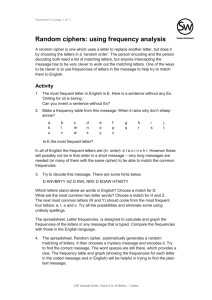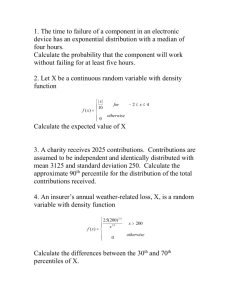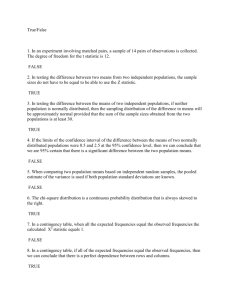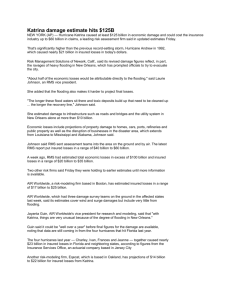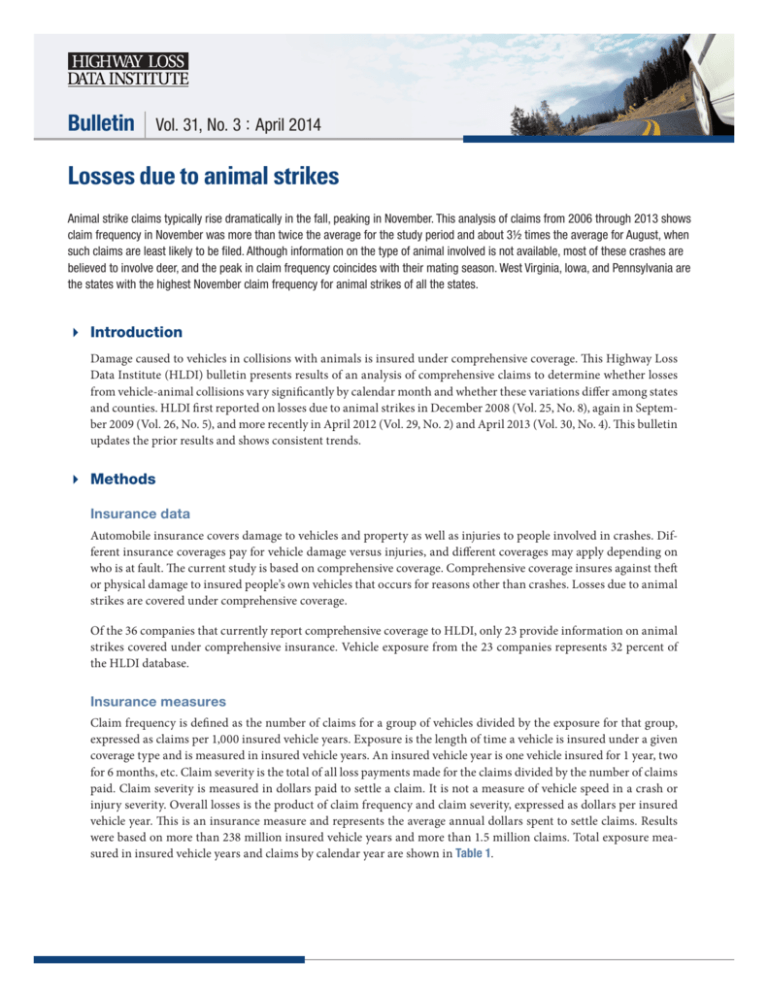
Bulletin
Vol. 31, No. 3 : April 2014
Losses due to animal strikes
Animal strike claims typically rise dramatically in the fall, peaking in November. This analysis of claims from 2006 through 2013 shows
claim frequency in November was more than twice the average for the study period and about 3½ times the average for August, when
such claims are least likely to be filed. Although information on the type of animal involved is not available, most of these crashes are
believed to involve deer, and the peak in claim frequency coincides with their mating season. West Virginia, Iowa, and Pennsylvania are
the states with the highest November claim frequency for animal strikes of all the states.
Introduction
Damage caused to vehicles in collisions with animals is insured under comprehensive coverage. This Highway Loss
Data Institute (HLDI) bulletin presents results of an analysis of comprehensive claims to determine whether losses
from vehicle-animal collisions vary significantly by calendar month and whether these variations differ among states
and counties. HLDI first reported on losses due to animal strikes in December 2008 (Vol. 25, No. 8), again in September 2009 (Vol. 26, No. 5), and more recently in April 2012 (Vol. 29, No. 2) and April 2013 (Vol. 30, No. 4). This bulletin
updates the prior results and shows consistent trends.
Methods
Insurance data
Automobile insurance covers damage to vehicles and property as well as injuries to people involved in crashes. Different insurance coverages pay for vehicle damage versus injuries, and different coverages may apply depending on
who is at fault. The current study is based on comprehensive coverage. Comprehensive coverage insures against theft
or physical damage to insured people’s own vehicles that occurs for reasons other than crashes. Losses due to animal
strikes are covered under comprehensive coverage.
Of the 36 companies that currently report comprehensive coverage to HLDI, only 23 provide information on animal
strikes covered under comprehensive insurance. Vehicle exposure from the 23 companies represents 32 percent of
the HLDI database.
Insurance measures
Claim frequency is defined as the number of claims for a group of vehicles divided by the exposure for that group,
expressed as claims per 1,000 insured vehicle years. Exposure is the length of time a vehicle is insured under a given
coverage type and is measured in insured vehicle years. An insured vehicle year is one vehicle insured for 1 year, two
for 6 months, etc. Claim severity is the total of all loss payments made for the claims divided by the number of claims
paid. Claim severity is measured in dollars paid to settle a claim. It is not a measure of vehicle speed in a crash or
injury severity. Overall losses is the product of claim frequency and claim severity, expressed as dollars per insured
vehicle year. This is an insurance measure and represents the average annual dollars spent to settle claims. Results
were based on more than 238 million insured vehicle years and more than 1.5 million claims. Total exposure measured in insured vehicle years and claims by calendar year are shown in Table 1.
Table 1: Exposure and claims by calendar year
Exposure
Claims
2006
25,781,032
145,368
2007
26,587,428
165,635
2008
27,228,181
175,886
2009
27,311,342
184,889
2010
28,833,939
196,148
2011
30,945,416
220,466
2012
33,142,379
227,945
2013
38,194,203
264,591
Total
238,023,920
1,580,928
Subject vehicles
The study period was from January 2006 through December 2013, and study vehicles included 1998-2014 model year
passenger vehicles. Motorcycles were not included.
Results
Figure 1 shows comprehensive claim frequencies for animal strikes during the 96-month study period per 1,000
insured vehicle years. Claim frequencies followed a consistent pattern — rising dramatically in October, peaking in
November, and then dropping off in December and January. Claim frequencies during the study period averaged 6.6
claims per 1,000 insured vehicle years.
Figure 1: National comprehensive claim frequencies for animal strikes,
January 2006–December 2013
20
August
November
15
10
5
0
HLDI Bulletin
2006
| Vol 31, No. 3 : April 2014
2007
2008
2009
2010
2011
2012
2013
2
Figure 2 summarizes the comprehensive claim frequencies during the 96-month study period into 12 months. Claim
frequencies were lowest in August (4.0 claims per 1,000 insured vehicle years) and highest in November (14.3). The
increase between August and November was about 3½ times.
Figure 2: National comprehensive claim frequencies for animal strikes,
2006–13, summarized for 12 months
20
15
10
5
0
Jan
Feb
Mar
Apr
May
Jun
Jul
Aug
Sep
Oct
Nov
Dec
Figure 3 shows comprehensive claim severities for animal strikes during the 96-month study period. Monthly variations in claim severities followed a pattern similar to that for claim frequencies. In general, over time there has been
an increasing trend in claim severity. This increase is believed to be associated with the increase in vehicle prices.
Claim severities during the study period averaged $2,811 per claim. In 2013, the most recent year, the average claim
severity was $3,085 compared with $2,424 in 2006.
Figure 3: National comprehensive claim severities for animal strikes,
January 2006–December 2013
$3500
August
November
$3000
$2500
$2000
HLDI Bulletin
| Vol 31, No. 3 : April 2014
2006
2007
2008
2009
2010
2011
2012
2013
3
Figure 4 summarizes the comprehensive claim severities during the 96-month study period into 12 months. Like
claim frequencies, claim severities were highest in November ($3,151 per claim). However, unlike claim frequencies,
claim severities were lowest in February ($2,478). The variation between minimum and maximum monthly claim
severities (27 percent) was not nearly as pronounced as the corresponding variation for claim frequencies.
Figure 4: National comprehensive claim severities for animal strikes,
2006–13, summarized for 12 months
$3500
$3000
$2500
$2000
Jan
Feb
Mar
Apr
May
Jun
Jul
Aug
Sep
Oct
Nov
Dec
Figure 5 shows comprehensive overall losses for animal strikes during the 96-month study period. The monthly
variation in overall losses followed the same pattern as that for claim frequencies. Overall losses during the study
period averaged $18.67 per insured vehicle year.
Figure 5: National comprehensive overall losses for animal strikes,
January 2006–December 2013
$60
August
November
$50
$40
$30
$20
$10
$0
HLDI Bulletin
| Vol 31, No. 3 : April 2014
2006
2007
2008
2009
2010
2011
2012
2013
4
Figure 6 summarizes the comprehensive overall losses during the 96-month study period into 12 months. Overall
losses were lowest in August ($10.68 per insured vehicle year) and highest in November ($45.18). Overall losses in
November were 4.2 times as high as those in August.
Figure 6: National comprehensive overall losses for animal strikes,
2006–13, summarized for 12 months
$60
$50
$40
$30
$20
$10
$0
Jan
Feb
Mar
Apr
May
Jun
Jul
Aug
Sep
Oct
Nov
Dec
Table 2 summarizes the animal strike loss results by month. National claim frequency was 6.6 claims per 1,000 years
of exposure with a claim severity of $2,811, resulting in an overall loss of $18.67.
Table 2: Comprehensive coverage losses for animal strikes,
2006–13, summarized for 12 months
Claim frequency
HLDI Bulletin
Claim severity
Overall loss
January
6.4
$2,555
$16.36
February
5.3
$2,478
$13.08
March
5.1
$2,530
$12.87
April
4.7
$2,593
$12.14
May
5.3
$2,786
$14.88
June
5.8
$2,828
$16.34
July
4.5
$2,733
$12.39
August
4.0
$2,675
$10.68
September
5.3
$2,743
$14.56
October
10.1
$3,010
$30.26
November
14.3
$3,151
$45.18
December
8.4
$2,785
$23.39
Total
6.6
$2,811
$18.67
| Vol 31, No. 3 : April 2014
5
Table 3 lists comprehensive coverage losses for the 10 states with the highest claim frequencies for animal strikes
in November. National data have been included for comparative purposes. To be included in the top 10 and in the
national total, states were required to have a minimum of 100 claims in November for each year. West Virginia tops
the list with a November claim frequency of 51.6—about 3½ times the national average for November and more
than 3 times higher than the state’s August claim frequency. Delaware, which is 10th on the list, had a November
claim frequency that was one-third higher than the national average for November. Among the 10 states, there was
not as much variation in claim severity between August and November as there was in claim frequency. Differences
between August and November overall losses among the states followed a pattern similar to that for claim frequencies. Map 1 illustrates the November animal strike frequencies by state. No threshold was applied to the map because
results are expressed in ranges. States that did not have a minimum of 100 claims in November for each year are noted
in the map.
Table 3: Comprehensive coverage losses for 10 states with highest claim frequencies
for animal strikes in November, 2006–13
Claim frequency
Claim severity
Overall loss
August
November
Percent
difference
August
November
Percent
difference
August
16.1
51.6
68.8%
$2,487
$2,828
12.0%
$40
$146
72.5%
Iowa
7.4
31.0
76.2%
$3,096
$3,641
15.0%
$23
$113
79.8%
Pennsylvania
6.0
29.6
79.7%
$2,430
$2,976
18.3%
$15
$88
83.4%
Kentucky
7.5
27.9
73.1%
$2,656
$3,300
19.5%
$20
$92
78.3%
Michigan
7.9
25.2
68.7%
$2,560
$3,146
18.7%
$20
$79
74.5%
North Carolina
6.2
24.8
75.0%
$2,124
$2,707
21.5%
$13
$67
80.4%
Virginia
5.0
21.2
76.5%
$2,399
$2,909
17.5%
$12
$62
80.6%
Arkansas
6.6
20.8
68.2%
$2,555
$3,021
15.4%
$17
$63
73.1%
Maryland
4.0
20.7
80.7%
$2,659
$3,264
18.5%
$11
$68
84.2%
Delaware
3.9
19.8
80.2%
$2,848
$3,273
13.0%
$11
$65
82.8%
National*
4.1
15.0
72.8%
$2,634
$3,139
16.1%
$11
$47
77.2%
West Virginia
November
Percent
difference
*Only includes states with ≥100 claims in each November
Map 1: November animal strike frequency by state, 2006-13
November animal strike claims
per 1,000 insured vehicle years
≥25
20 to 24
15 to 19
10 to 14
5 to 9
<5
does not meet 100 November
claims threshold
Note: All Massachusetts data is supplied to HLDI by the Automobile Insurance Bureau of Massachusetts.
They do not provide data on animal strikes and therefore Massachusetts has been excluded.
Note: States are included on this map even if they did not meet the minimum claims threshold needed in Table 3.
HLDI Bulletin
| Vol 31, No. 3 : April 2014
6
Figure 7 shows comprehensive claim frequencies for animal strikes during the 96-month study period for the three
states with the highest November claim frequencies (West Virginia, Iowa, and Pennsylvania) and two states with very
low November claim frequencies (California and Florida). Claim frequencies for West Virginia, Iowa, and Pennsylvania followed the national trend but were consistently higher than the national average. There was little variation in
claim frequencies for California and Florida.
Figure 7: Comprehensive claim frequencies for animal strikes in selected
states compared with national average, January 2006 – December 2013
70
Florida
Iowa
Pennsylvania
West Virginia
California
National
60
50
40
30
20
10
0
2006
2007
2008
2009
2010
2011
2012
2013
Table 4 lists comprehensive coverage losses for the 20 counties with the highest claim frequencies for animal strikes
in November. National data have been included for comparative purposes. To be included in the top 20, counties were
required to have a minimum of 100 claims in November for each calendar year. Butler County, Pennsylvania, tops the
list with a November claim frequency of 53.1 — 3½ times the national average for November and more than 5 times
higher than the county’s August claim frequency. Six of the 20 counties had November claim frequencies that were
more than twice the national average. Among the 20 counties, there was not as much variation in claim severity as
there was for claim frequency. Differences between August and November overall losses among the states followed
a similar pattern to that for claim frequencies. Map 2 illustrates the November animal strike claim frequencies by
county for the Northeastern region of the country. A lower exposure threshold was applied to the map because results
are expressed in ranges.
HLDI Bulletin
| Vol 31, No. 3 : April 2014
7
Table 4: Comprehensive coverage losses for 20 counties with highest claim frequencies
for animal strikes in November, 2006-13
Claim frequency
August
Claim severity
November
Percent
difference
August
November
Overall loss
Percent
difference
August
November
Percent
difference
Butler, PA
9.8
53.1
81.6%
$2,375
$3,042
21.9%
$23
$162
85.6%
Washington, PA
6.9
39.6
82.5%
$2,626
$2,874
8.6%
$18
$114
84.0%
Westmoreland, PA
7.3
39.1
81.3%
$2,519
$2,856
11.8%
$18
$112
83.5%
Orange,NY
7.6
35.0
78.3%
$3,443
$3,671
6.2%
$26
$128
79.6%
Frederick, MD
6.6
33.5
80.3%
$2,290
$3,027
24.4%
$15
$101
85.1%
Erie, PA
5.8
33.0
82.4%
$2,499
$3,155
20.8%
$15
$104
86.1%
Loudoun, VA
5.6
27.4
79.5%
$2,567
$3,250
21.0%
$14
$89
83.8%
Chester, PA
4.0
25.1
84.2%
$2,560
$3,434
25.5%
$10
$86
88.2%
Howard, MD
4.0
21.4
81.4%
$3,032
$3,190
5.0%
$12
$68
82.3%
Wake, NC
3.4
19.7
82.6%
$2,375
$3,081
22.9%
$8
$61
86.6%
Allegheny, PA
3.6
18.5
80.8%
$2,408
$2,908
17.2%
$9
$54
84.1%
Prince William, VA
3.3
17.8
81.4%
$2,707
$3,173
14.7%
$9
$57
84.1%
Bucks, PA
3.6
16.9
78.8%
$2,997
$3,431
12.7%
$11
$58
81.5%
Montgomery, MD
3.3
15.1
78.4%
$2,683
$3,099
13.4%
$9
$47
81.3%
Monroe, NY
2.8
15.0
81.6%
$2,406
$3,227
25.5%
$7
$48
86.3%
Erie, NY
3.1
14.9
79.0%
$2,505
$3,172
21.0%
$8
$47
83.4%
Prince George's, MD
2.4
14.8
83.7%
$2,629
$3,434
23.4%
$6
$51
87.5%
Montgomery, PA
2.4
14.7
83.5%
$2,404
$3,256
26.2%
$6
$48
87.8%
Anne Arundel, MD
2.2
14.2
84.4%
$2,775
$3,675
24.5%
$6
$52
88.3%
Baltimore, MD
2.3
13.0
82.3%
$2,550
$3,371
24.3%
$6
$44
86.6%
National
4.1
15.0
72.8%
$2,634
$3,139
16.1%
$11
$47
77.2%
Map 2: November animal strike frequency by county, 2006-13
Animal strike frequency
per 1,000 insured vehicle years
≥80
50 to 79
20 to 49
10 to 19
<10
Note: All Massachusetts data is supplied to HLDI by the Automobile Insurance Bureau of Massachusetts.
They do not provide data on animal strikes and therefore Massachusetts has been excluded.
Note: Counties are included on this map even if they did not meet the minimum exposure threshold needed in Table 4.
HLDI Bulletin
| Vol 31, No. 3 : April 2014
8
Discussion
November is the peak month for animal strikes. Insurance claims for animal collisions are nearly 3 times as
high during November as in a typical month earlier in the year. The insurance claims data available to HLDI do
not specify the animals involved, but deer are likely the main ones. The November peak in animal strike claims
coincides with the deer mating season, when bucks are likely to be roaming. That may also help explain the rise
in severity at this time. A greater proportion of the struck animals in October and November are likely to be deer,
which cause more severe damage than smaller animals.
References
Highway Loss Data Institute. 2008. Losses due to animal strikes. Loss Bulletin Vol. 25, No. 8. Arlington, VA.
Highway Loss Data Institute. 2009. Losses due to animal strikes. Loss Bulletin Vol. 26, No. 5. Arlington, VA.
Highway Loss Data Institute. 2012. Losses due to animal strikes. Loss Bulletin Vol. 29, No. 2. Arlington, VA.
Highway Loss Data Institute. 2013. Losses due to animal strikes. Loss Bulletin Vol. 30, No. 4. Arlington, VA.
The Highway Loss Data Institute is a nonprofit public service organization that gathers, processes, and publishes insurance data
on the human and economic losses associated with owning and operating motor vehicles.
1005 N. Glebe Road, Suite 700
Arlington, VA 22201 USA
tel 703/247-1600
fax 703/247-1595
iihs-hldi.org
COPYRIGHTED DOCUMENT, DISTRIBUTION RESTRICTED © 2014 by the Highway Loss Data Institute. All rights reserved. Distribution of this report is restricted. No part of this publication may be reproduced, or stored in a retrieval system, or transmitted, in
any form or by any means, electronic, mechanical, photocopying, recording, or otherwise, without the prior written permission of
the copyright owner. Possession of this publication does not confer the right to print, reprint, publish, copy, sell, file, or use this
material in any manner without the written permission of the copyright owner. Permission is hereby granted to companies that
are supporters of the Highway Loss Data Institute to reprint, copy, or otherwise use this material for their own business purposes,
provided that the copyright notice is clearly visible on the material.

